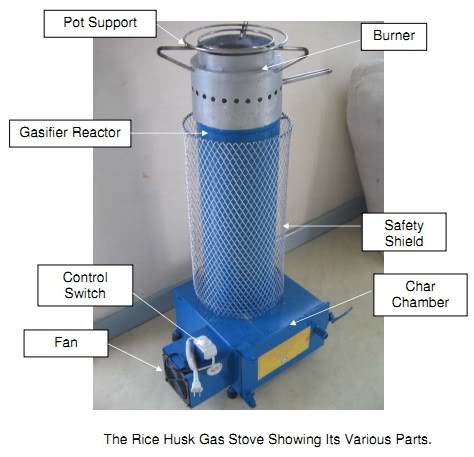The use of Liquefied Petroleum Gas (LPG) is one of the conventional sources of fuel for cook stoves in the Philippines. However, because of the continued increase in the price of LPG fuel and is continuously increasing at a fast rate, research centers and institutions are challenged to develop a technology for cooking that will utilize alternative sources other than LPG. The potential of biomass especially rice husk waste as alternative fuel source to replace LPG is a promising option.

Rice husk biomass wastes are abundant after harvest of each crop that can be found as piles at the back of the rice mill where they are stacked for disposal or some are thrown and burned.
If this waste can be converted into fuel for domestic cooking, there will be a lot of households that can be benefited, and more dollar savings for the country can be achieved. Because of this reason, the Belonio Rice Husk Gas Stove, a gasifier stove that uses rice husk for fuel, was invented by Alexis Belonio, a Filipino agricultural engineer.
However, there are already cooking stoves fueled by rice husks in the Philippines [One is Sipag kalan developed by Aga Milagroso of Malolos, Bulacan.] But unlike the others which directly burn the husks, Belonio’s invention first converts the husks into gas to emit a cleaner flame.
The rice husk gas stove developed at the Appropriate Technology Center of the Department of Agricultural Engineering, College of Agriculture, Central Philippine University, Iloilo City was proven to produce a luminous blue flame for cooking using rice husks as fuel. Employing the concept of burning fuel in a controlled environment can gasify rice husks to produce a fuel like LPG.
The Belonio rice husk gas stove was found to have the following benefits, not only to users but to the general public as well:
1. Big fuel savings. It is a good replacement for LPG stove. According to Belonio, a ton of rice husks that are freely available in the countryside, could replace about 23 11-kilogram tanks of LPG.
2. Environment friendly. It will help minimize the problem on rice husk disposal which contributes a lot on environmental pollution, especially the burning of this waste on roadsides and the dumping of the same along river banks.
3. Employment and Income. It will provide employment and income generating projects for Filipinos in the production and marketing of the stove, and even in the selling of rice husk fuel in the future.
Detailed Procedure in Fabricating the Rice Husk Gas Stove
The procedure below gives the specific steps being followed at present in fabricating the rice husk gas stove. All the metal sheet works is the first phase of work that must be done followed by metal bars work. In terms of parts, the char chamber and the fan housing are the first work to be done followed by the installation of the fuel reactor. The burner assembly comes next which is to be followed by the door assembly and char grate assembly. All metal bars activities are the last activities before painting the stove and installing the fan and switches.

Below is the step-by-step procedure in fabricating the stove:
1. Make a lay out of the char chamber, fuel reactor outer cylinder, fuel reactor inner cylinder, fuel reactor flange, and fan housing assembly on the steel sheet. Then, cut these various components as required. Allow at least 1/4 of an inch as overlap.
2. Fold the sheets into the various forms as required. For the char chamber, fold the sheet to make it into box as illustrated in Appendix 6 of the handbook. The same process should be done for the fan housing. Roll the inner and outer cylinders of the reactor according to the diameter of the cylinder required.
3. Weld all connecting parts of the char chamber box, fan housing, and the cylinders’ longitudinal length. Welding should be done with overlap to prevent possible occurrence of gap that would cause spillage of the rice husk ash insulator.
4. Weld the fan housing and the reactor cylinders into the char chamber. The fan housing is positioned at one side of the reactor while the fuel reactor is on top. As shown in the drawing (refer to the handbook), the cylindrical hole at the topmost end of the char chamber is intended for the installation of the inner reactor cylinder. The outer cylinder, on the other hand, is to be placed enclosing the inner reactor. The clearance between the inner and the outer cylinder must be the same throughout the circumference.
5. Fill the reactor with rice husk ash to the top. Press the ash so that all spaces will be filled with insulation.
6. Close the space between the inner and the outer reactor with flange and weld it.
7. Make a layout of the burner cylinder assembly. This includes the top plate, flanges, inner cylinder, and outer cylinder. Cut these components according to the required sizes.
8. Drill holes on the top plate and at the outer cylinder. The series of holes at the topmost portion of the plate, which serves as gas exhaust, should be drilled first followed by the holes in the outer cylinder, which serve as entrance for the secondary air.
9. Roll the inner and the outer sheets of the burner cylinders as required. Weld them together with oxyacetylene welding to make sure that no gas escapes during operation. Attach the flanges and weld them to form a burner. Make sure that the burner properly fit to the reactor, without possible leakage of gases during operation.
10. Make a layout of the door assembly for the char chamber. The door must be well fitted and can be easily opened or closed during operation. All edges of the door should be bent inward to properly secure it in place during operation and to provide better stiffening job to the material. Properly attach the door hinges and locks.
11. Cut all steel bars as specified in the design. This will include the support leg, frame for the char grate and the lever, pot support and handle, and the frame support for the safety shield.
12. Weld all the bars as required. Starting from the support legs, char grate frame and lever, burner pot support and handle, to safety shield frame.
13. Apply metal putty on some depressions on metal surfaces and smoothen it with sand paper.
14. Apply paint on the surface of the metal by spraying it with enamel paint. Allow the paint to dry overnight.
15. Assemble the fan and switch.
For the complete rice husk gas stove design, list of materials needed for fabrication and the cost of producing and utilizing the stove, you may download this Rice Husk Gas Stove Handbook by Alexis T. Belonio
Alexis Belonio: Pitong Pinoy Awardee – Rice Husk Stove Video
Source and Photos:
Belonio, A.T. (2005). Rice Husk Gas Stove Handbook. Appropriate Technology Center. Department of Agricultural Engineering and Environmental Management, College of Agriculture, Central Philippine University, Iloilo City, Philippines.




saan po pwdeng bumili ng rice husk stove?
Lot's of information in the net about gasifiers, but almost no source where to buy it if any at all. Anyone here having a source where to buy this in the Philippines? Thanks.
San po s metro minla puede makbili ng brother nyo. Tnx
San po puede makbili ng belonio stove… Pls reply. Tnx
pano po makakabili?
Sir where can I buy your rice hull stove? I am very much interested
I'm from West Visayas State University taking up Development Communication, I wouldlike to ask if I can use this study regarding to my Science Communication subject. I would like to work with this article regarding this study. Hoping for ur reply .Thankyou so much.
Saan makabili nito. Ku ng di pa available baka pwede makakuha ng blue print. Malaking tulong ito sa taga rural areas . Rice husk dito sa cagayan sinusunog lang.
saan po ako makakabili at contact number ng supplier, ty po…
sana pinakita ang inside parts ng stove na ito .. i just wanted to know how the flame was made and how the air passes through the chamber thingy , and how deep the rice husk is positioned in the stove's body 🙂 thank you po 🙂 God bless
where can I find this stove? is this available in Palawan.
try sulit.com…. rice husk stove
wer i can buy this po>
san po nakkabile nian sa gapo
pWEDE PO BANG MALAMAN ANG CONTACT NUMBER NG SUPPLIER NITONG BELONIO RICE HULL STOVE? UMAAPOY PO KASI ANG DAMDAMIN KO NA MAGKAROON NG STOVE NA ITO:)
PAANO MAKABILI NG BELONIO RICE HULL STOVE?
PAANO MAKABILI NG BELONIO RICE HULL STOVE?
i want to be a dealer of belonio stove rice hush
Good day!
Commercialized BELONIO Rice husk Gas stove is already available FOR SALE!
SRP 2,400 Pesos only! Free shipping! 1 day delivery!
Pls contact:
Mr. Michael
Biz.bulacan@gmail.com
(Globe) – 09172032510
(Smart) – 09381745244
(Sun) – 09332516027
Dealers/Distributors are welcomed! Start your business and Contact now!